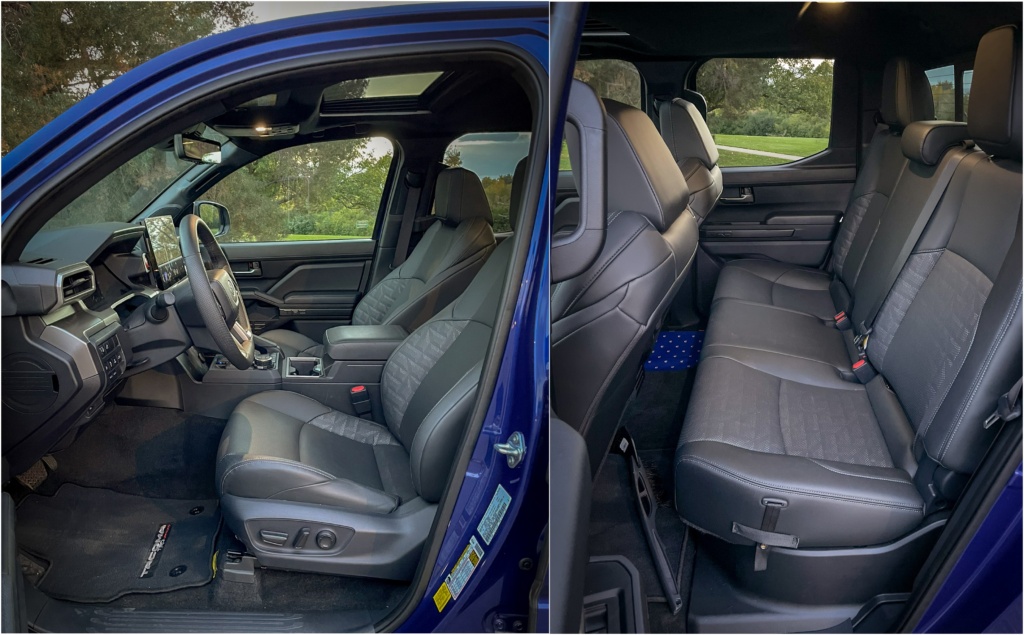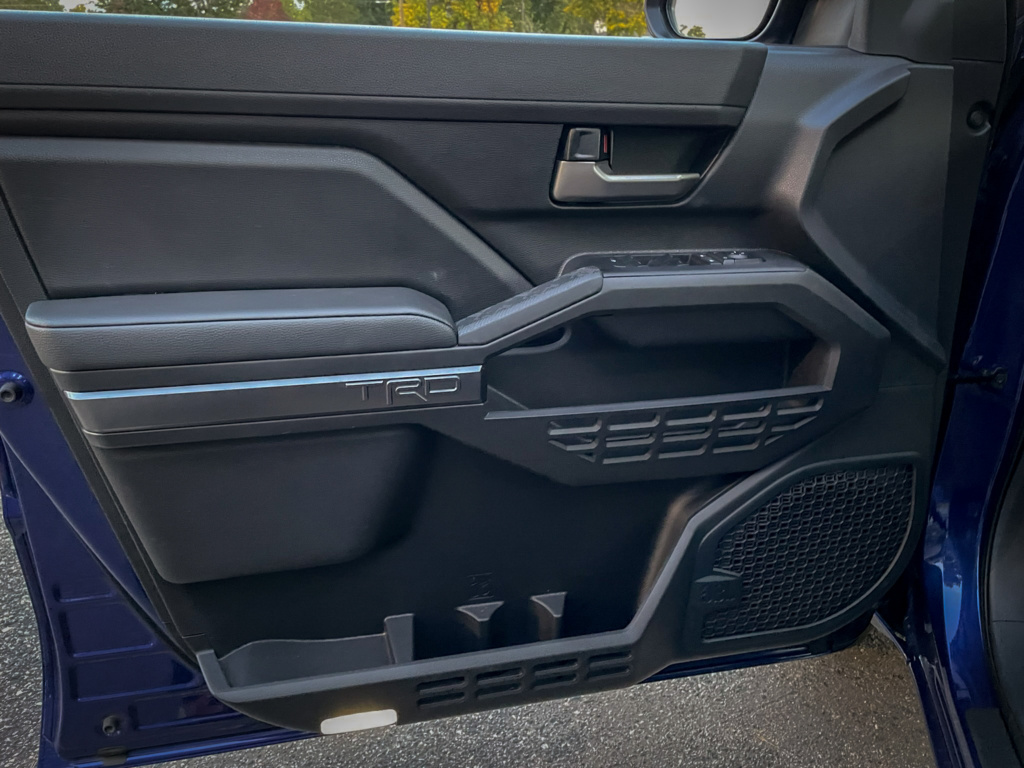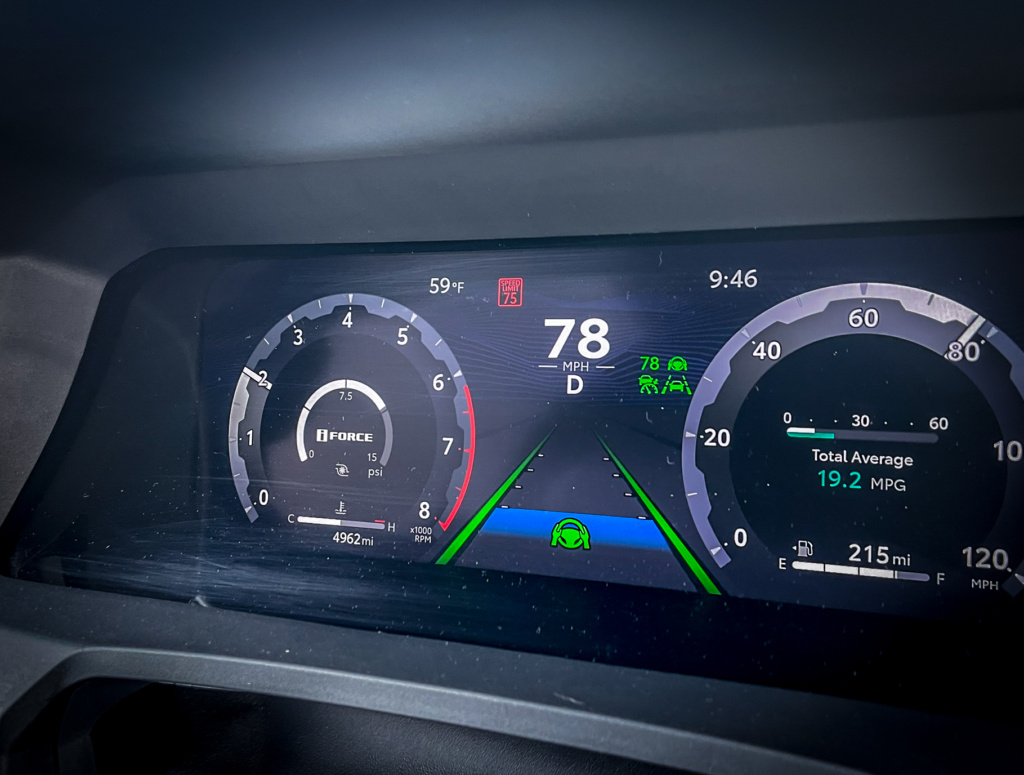
You’re not alone if you mistake the new Toyota Tacoma for its full-size brethren, the Tundra. Its tall front end, bulky body shapes, and wide stance deliver a big truck appearance but it remains notably more parking lot (and trail)-friendly. It continues to improve and even includes a more playful design, especially in one of the numerous bulked-up adventure-ready (like this TRD Off-Road) trims.

The side profile is a blend of past influences and something entirely new. The sloped windshield is familiar as are the amplified fender flares and the sharpened lower door styling line, however, the rear roof spoiler is entirely fresh and the sharp lines at the front and rear ends are so “in” right now. And even after those fads have shifted, the Tacoma’s balanced proportions, high-stance body, and wide track bring a balance of youthful design with an authentic sense of adventure.

The mix of sharp angles and long lines create large surfaces and continue the large-truck look around to the rear. The extended “spoilers” seen on the roof and tailgate, along with the smart use of panel gaps (such as the rear bumper to fender), and smooth rear glass window also contribute to a dynamic look with a touch of premium design.

The bed is an area of steady (but slow) advancement. The Tacoma maintains the use of its composite bed and provides extra utility through several power outlets, ample LED lighting, and a couple of small cubby spaces. Little victories.

An optional power tailgate lowers and lifts through the use of any of its several switches, including one located cleverly within the plastic tail light housing. Additional switches are located in more “traditional” locations such as on the key fob, in the cab, and the tailgate handle. Once you experience the power tailgate, the new-found practicality makes one wonder why all trucks aren’t equipped with one.
Climbing into the bed will bring about the opposite question: “Why isn’t this easier?” as there is no assist device such as a grab pole or integrated bumper step. It’s a glaring compromise toward styling.

The interior seats five but rear passengers will find limited space and uncomfortable seats. It’s not a big deal for most Tacoma owners, apparently, as Toyota says most will never put passengers back there. That also explains the lack of rear air vents. Frustratingly, the space also isn’t all that great at converting to a storage area either.

Making your way into the cabin requires a hop-up maneuver; however, once inside, it is easy to find a comfortable position. The driver’s seat provides a wide range of adjustability, and the large steering wheel feels good to hold, with a firm shape and perforated synthetic leather. And despite the very large touchscreen, the interior features an abundance of physical controls.

Despite all of the spaces and curves molded in for storage, the door’s shallow bins and hard plastic limit what could really be stored here that won’t either rattle or just fall out. Focusing on the functions of a door, its solid grab handle, padded armrest, and easily accessible controls are appreciated daily.

The Tacoma’s digital gauge cluster displays information clearly although accessing certain information (such as the TPMS) is less intuitive than it ought to be.

At first sight, the Tacoma’s center console fits the bill. A tall and large shifter and a button or knob for just about every feature are a great start. But spending time in the Tacoma reveals that, much like its larger brother, the Tundra, the center console could use a lot more structural rigidity and learning the location of said buttons, such as traction control, the surround-view camera, and the power tailgate, requires repetition to be able to locate quickly.

The animation team looks like they received a big budget and the digital display brings more theater to the cockpit. It also utilizes some of the display space to convey settings for certain drivetrain features such as speed for crawl control.

This is the primary reason to upgrade from your current Tacoma. The 2.4-liter turbocharged engine and eight-speed transmission are an excellent pairing and an undeniable improvement over the large but weak-kneed 3.5-liter V6 and humble six-speed transmission of the last generation Tacoma.
The four-cylinder adds a friendly clatter to the Tacoma’s soundtrack while its relaxed but strong power curve and smartly-schooled transmission make everyday driving less distracting. The highway cruising experience is also incredibly improved, as the turbocharger can help the engine achieve the necessary power without the shock or noise that comes with a high-load downshift.

Other big advantages brought with this new Tacoma are a sway-bar disconnect system (that is better than Jeep’s design) and a coil-spring rear suspension system. Both features allow for improved off-road and on-road performance, however, the everyday ride and handling are still very much in the pick-up truck category of overall refinement.

The TRD Off-Road package is legit and low-hanging components, such as this transfer case receive the necessary protection – even if it is just the cutest little skid-plate you’ve ever seen.

The aforementioned features and designs create a Tacoma that is better in every way but most notably with respect to its overall drivability. From the strong engine to the improved braking system, the added off-road systems, and even the portable center dash speaker, the new generation of Tacoma is one of the rare instances where every part of the vehicle feels upgraded and fresh, yet the truck remains entirely familiar. It not only matches the high expectations set by previous generations but exceeds them to now (rightfully) sit at the top of the segment.
Toyota provided the Tacoma for review by Pilgrim Motor Press.
